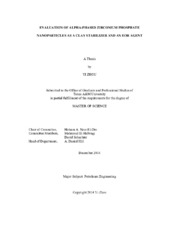| dc.description.abstract | Fines migration, which is the detachment and movement of fines from sand surfaces, leads to the plugging of throats in porous media and becomes an important reason for formation damage. Enhanced Oil Recovery (EOR) is the technique to extract more oil after secondary recovery. Nanoparticles are used as clay stabilizers and EOR agent because of their very small size, large surface area, and surface electrical charge. In this paper, an α-ZrP nanoparticle-based treatment is developed to prevent fines migration in sandstone formations and recovery more oil in carbonate.
To test the ability of α-ZrP nanofluids as a clay stabilizer, coreflood tests were conducted using alpha phased zirconium phosphate based nanofluids as a clay stabilizer with Berea sandstone cores (6 in. in length, 1.5 in. in diameter) under a pressure of 1000 psi and temperature of 300°F. In these experiments, α-ZrP nanofluids were injected at concentrations of 0.1, 0.5, and 1.0 wt% at a flow rate of 2 cm^3/min. Both DI water and brine were used as diluting agents. After each treatment, a post-flush of fresh water was applied. The pressure drop across the core was measured, the core effluent samples were collected, and the permeability changes were calculated. Also, the surface tensions and viscosities of the treatment fluids were measured.
Lab results indicated that α-ZrP nanofluid mitigated fines migration in Berea sandstone up to 300°F. Because fresh water tends to cause formation damages, nanoparticles diluted with brine showed less permeability change than those diluted with DI water. The best treatment we had was the α-ZrP nanofluid diluted with brine (5 wt% KCl) at a concentration of 0.5 wt%.
To use α-ZrP nanofluids as an EOR agent, Indiana limestone core was pre-flushed with brine, and then saturated with oil (dodecane). In addition, brine was injected again with different flow rates of 0.5, 1.0 and 2.0 cm^3/min for about 5 PV each. After that, 1 PV of EOR agent was injected at 0.5 cm3/min from bottom to top. A post-flush of brine was applied and the effluents were collected to find out the total oil recovered. The test result gave a 13.68% oil recovery in the EOR stage.
The alpha-phased zirconium phosphate nanofluids had never been applied before for subsurface use. It was discussed as an clay stabilizer and EOR agent in this study. This work provides new insights into the application of nanoparticles in the oil and gas industry. | en |


